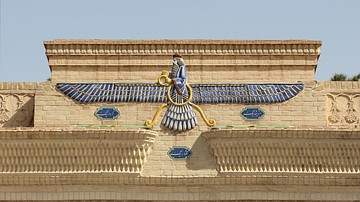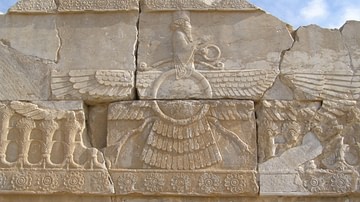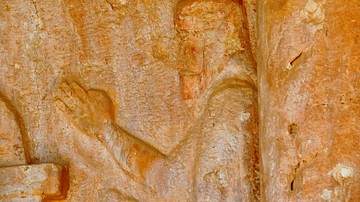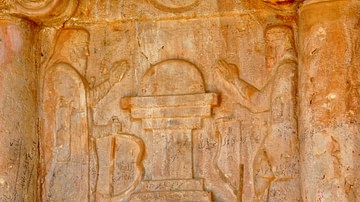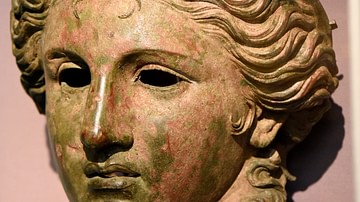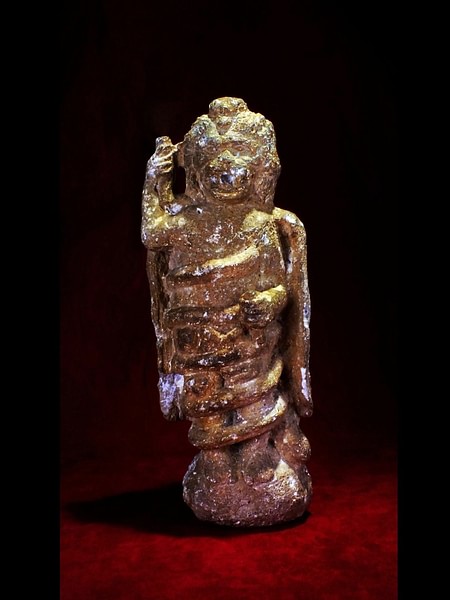
Ahriman is the evil spirit in Early Iranian Religion, Zoroastrianism, and Zorvanism, Lord of Darkness and Chaos, and the source of human confusion, disappointment, and strife. He is also known as Angra Mainyu (evil spirit or dark spirit) and exists in opposition to Spenta Mainyu (good spirit or bright spirit) also known as Ahura Mazda and Ormuzd.
In the early polytheistic Persian religion, Ahura Mazda was the king of the gods and creator of the world, and Angra Mainyu/Ahriman, lord of the legions of demons, his opponent. After the reforms of Zoroaster (c. 1500-1000 BCE), resulting in the monotheistic religion of Zoroastrianism, Ahura Mazda became the one true god, and all the other deities emanations and avatars of his power, but Ahriman remained the source and embodiment of evil.
Zoroastrianism replaced the earlier belief system and was adopted by the Achaemenid Empire (c. 550-330 BCE). At some point late in the empire's history (or much earlier, according to some scholars), the question arose as to how Ahriman – and therefore evil – could exist in a world created by an all-good, all-powerful divine being. This question was answered by Zorvanism (often referred to as a heretical sect of Zoroastrianism) which made Zorvan, a minor god of time in Early Iranian Religion, the supreme being and Lord of Infinite Time.
Zorvan gave birth to both Ahura Mazda and Ahriman and, therefore, Ahura Mazda was not responsible for evil; evil was the result of Ahriman's own choice to pursue the opposite of Ultimate Good. The figure of Ahriman, adversary of the divine good and instigator of strife, is thought to have influenced the creation of similar supernatural entities in later religions such as Satan in Judaism, the devil in Christianity, and Iblis in Islam.
Early Appearance & Character
Early Iranian Religion developed in the region known as Greater Iran (the Caucasus, Central Asia, South Asia, and West Asia prior to the 3rd millennium BCE when one branch of a migratory people (known as Aryans meaning “noble” or “free”) settled in “the land of the Aryans”, Iran. Their religion was polytheistic and was kept through oral tradition, passed down generation to generation through stories, rituals, and traditions.
This belief system was reformed by the prophet Zoroaster who reimagined the earlier gods and created a new religion – Zoroastrianism – which was monotheistic. This faith also maintained an oral tradition which was not committed to writing until the time of the Sassanian Empire (224-651 CE) and most of what is known of the Early Iranian Religion comes from Zoroastrian texts such as the Avesta, the Bundahisn, the Denkard, and the Vendidad, which reference the earlier gods and the stories – now known as ancient Persian mythology – of how the world, humans, and the gods came to be as well as the Shahnameh (Book of Kings), a collection of legends and myths, and other works.
Ahriman appears in the Zoroastrian texts without introduction as though an audience should already be familiar with him, no doubt a carry-over from the earlier oral tradition. He, therefore, has no origin story or development and appears for the first time as fully developed as he will ever become. Scholar John R. Hinnels describes Ahriman's nature:
He is the demon of demons, and dwells in an abyss of endless darkness in the north, the traditional home of the demons. Ignorance, harmfulness, and disorder are the characteristics of Ahriman. He can change his outward form and appear as a lizard, a snake, or a youth. His aim is always to destroy the creation of [Ahura Mazda] and to this end he follows behind the creator's work, seeking to spoil it. As Ahura Mazda creates life, Ahriman creates death; for health, he produces disease; for beauty, ugliness. All man's ills are due entirely to Ahriman. (52)
The early religion maintained that the world was created by Ahura Mazda in seven steps:
- Sky
- Water
- Earth
- Plants
- Animals
- Human Beings
- Fire
Sky was an orb into which Ahura Mazda poured water and then separated the waters with earth and spread vegetation across the land. He then created Gavaevodta, the Primordial Bull (also given as “the uniquely created bull” Primordial Bovine, and Primordial Ox) who was so beautiful that Ahriman killed it. Ahriman did not kill Gavaevodta for any particular reason; he did it simply because he wanted to and because he could. This event characterizes all of Ahriman's subsequent actions as does Ahura Mazda's response.
Ahura Mazda carried the corpse of Gavaevodta to the moon where it was purified and from the purified seed all animals were created. Ahura Mazda had thereby turned Ahriman's act of evil toward a positive end. Ahura Mazda then created the first man, Gayomartan (also given as Gayomard, Kiyumars) who is also beautiful and quickly killed by Ahriman. The sun purifies the seed of Gayomartan and, after 40 years, a rhubarb plant grows from it to birth the first couple – Mashya and Mashyanag. They live in harmony with the earth, animals, and their creator until Ahriman appears and whispers lies to them, telling them he is their creator and Ahura Mazda the deceiver and their enemy.
The couple believe these lies and so sin enters the world through their doubt, and their harmony with animals and each other is lost. They cannot even conceive a child for many years after their fall and, when Mashyanag finally does give birth, they eat the children because they have lost all recognition of reason. They eventually give birth to twins who go on to populate the earth, but Ahriman's lies have corrupted the earlier paradise and humans will now live in strife, at odds with animals and each other.
After the birth of Gayomartan, Ahura Mazda had made fire as his last aspect of creation but, with Ahriman's interference and the fallen nature of humanity, gods now had to be created to help people through life and, especially, aid them in making the pivotal choice between deciding to follow the path of Ahura Mazda or that of Ahriman as this choice would define each person's life on earth and after death.
Zoroastrianism
Whether this emphasis on choice and the importance of human free will actually was a part of Early Iranian Religion is impossible to know. It is thought that it was because of how certain passages of the later Zoroastrian texts are interpreted but, since Zoroaster completely reformed the older religion, it is possible that the significance of free will is a later development.
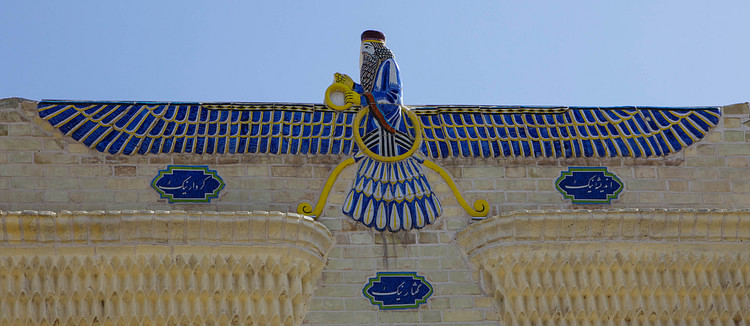
Zoroaster had been a priest of the old religion who received a revelation that the divine message had been misunderstood and was being interpreted wrongly. Ahura Mazda, he was told, was the only god – not one of many – and the present religious belief had to be reformed. Zoroaster met with strong resistance in preaching his new faith until he managed to convert the king Vishtaspa who then converted his people and Zoroastrianism was established.
Ahriman continued as the adversary of Ahura Mazda while other gods were either reimagined as demons or as emanations of different aspects of Ahura Mazda's divine being. The new faith was founded on five principles:
- Ahura Mazda is the supreme and only god
- Ahura Mazda is all-good
- Ahura Mazda's opponent, Angra Mainyu (Ahriman), is all-evil
- Goodness is made manifest through Good Thoughts, Good Words, Good Deeds
- Each individual has free will to choose between good and evil
The new faith, presumably, covered all the aspects the older belief system had, only from a monotheistic perspective, and retained the same weakness: if the all-good Ahura Mazda had created the world, where had evil come from? There was no creation myth which provided for Ahriman's origin nor for the existence of the daevas, the legions of demons he commanded, and so it would appear that Ahriman came from Ahura Mazda, which could not be since evil could not originate from ultimate good.
The Problem of Evil & Zorvanism
The problem of evil was, in fact, more difficult to resolve now in the monotheistic paradigm because Ahura Mazda was the first and uncreated being in the universe from which all else had come. If this were so, then evil should not exist – and yet human experience contradicted this – so Ahura Mazda could not be the creator of a world which included evil.
This problem was addressed by the so-called “heresy” of Zorvanism, which made Zorvan, a minor deity of time in Early Iranian Religion, the Supreme Being and God of Infinite Time. Zorvan, the uncreated creative principle in the universe, wished to have a child and so prayed to himself for progeny. As he was doing this, he experienced a moment of doubt whether his desire was a good one and, in this moment, Ahriman was engendered and then, once it had passed, Ahura Mazda.
Ahriman cut his way out of the primordial womb before it was time for his birth, knowing that the first-born would have dominion over the world, but Zorvan placed a limit of time on his reign – 9,000 years – after which Ahura Mazda would defeat him and take his place. Ahura Mazda was still responsible for the creation of the world and everything in it, but evil came from that moment of Zorvan's doubt in his own impulse toward creation.
Zorvanism thus solved the problem of evil and Ahura Mazda could still be the all-powerful and all-good creator, but this solution contradicted the central premise of Zoroastrianism: the pre-eminence of human free will. If Time was the all-powerful first principle then one's choices were irrelevant because Time created all things, moved all things, destroyed all things and there was nothing one could do about that. Whether one made Choice A or Choice B, one was still subject to Time. With Time as the ultimate power in the universe, and Ahura Mazda as a created being, supplications to him could not have the final effect they had in Zoroastrian belief because now there was a power greater than Ahura Mazda.
It was not until the 19th century CE that an explanation for Ahriman's existence was given and the problem of evil resolved. The German Orientalist, Martin Haug (l. 1827-1876 CE) proposed that Ahriman actually did not exist as a deity but as the destructive negative energy discharge of Ahura Mazda's act of creation. This would be comparable to a person releasing a certain amount of energy during exercise if that energy then became sentient. Ahriman was not “born evil” in Haug's view but was just another emanation of Ahura Mazda – like any of the other gods in the Zoroastrian interpretation – except that, unlike them, he chose to do evil. Evil, then, came from Ahriman's exercise of free will, not from Ahura Mazda's act of creation.
Ahriman's Goals & the Tale of Zahak
This suggestion was accepted by the Zoroastrian Parsees of India – devotees who had saved the sacred texts from the Muslim Arab invasion of Iran in 651 CE and taken them out of the country – and supported by stories concerning Ahriman in these texts. Scholar J. Duchesne-Guillemin, referencing the Zoroastrian tradition and Persian tradition, writes:
Ahriman is evil by choice. “It is not,” he says, “that I cannot create anything good, but that I will not.” And to prove this, he created the peacock. (Encyclopedia Iranica, Ahriman, 8)
Ahriman's dedication to subverting any good advanced by Ahura Mazda was not any kind of means to an end but the end itself; destroying the good and disrupting order at every turn was his only interest. At any given time, he could as easily have used his power to elevate people instead of destroying them, but this did not interest him, as illustrated in the tale of the prince – and later king – Zahak (also known as Zahhak).
Zahak was the son of a kind and just king named Merdas in the mythological time when the great king Jamshid ruled the world. Zahak was handsome and charming but had been spoiled by his father and was weak of will, lazy, and prone to being led astray by bad company. One day, he met an equally charming and handsome young man (actually Ahriman in the form of a youth), and the two became good friends. By slow degrees, Ahriman began to suggest how easy it would be for Zahak to kill his father and become king and, eventually, he followed his new friend's advice.
After Zahak became king, his friend vanished just as a new cook (Ahriman again) was hired at the palace. This cook could make any meal in the world and each more wonderful than the last. Zahak wanted to reward him and asked what he would like, but the cook refused any treasure or honor and asked only to be allowed to kiss Zahak on his shoulders. This granted, serpents suddenly burst from the places the cook had kissed and the cook himself vanished.
Zahak wanted the snakes removed, but each time they were cut off, they sprung up again. Fortunately – or so Zahak thought – a new physician arrived at the palace who was especially skilled (Ahriman again) and said he had a remedy: the only way to deal with the problem was to feed the snakes human brains every day and, if this was not done, the snakes would eat Zahak's own.
At this time, Jamshid had been ruling the world in peace and harmony for 300 years but Ahriman visited him, whispering softly in his ears, and – as he had done long ago with the very first king, the wise Yima – convinced Jamshid he had no need of the gods and caused him to think more highly of himself than he should. Jamshid's reign became corrupt and his people suffered and so when Zahak moved against him, he had everyone's support. Zahak overthrew Jamshid, had him sawn in half, and took the throne of the world.
The people were overjoyed until they found Zahak an even worse despot than Jamshid had become and, further, were losing friends and relatives daily who were taken to the palace to be killed for their brains to feed Zahak's shoulder-snakes. Zahak's reign of terror continued until the blacksmith Kaveh, who had lost 18 sons to Zahak's snakes, raised a rebellion and enlisted the aid of the hero Fereydun (also known as Thraetaona) to lead the people. Zahak was overthrown and left bound and bleeding in captivity as Fereydun restored order and peace to the land.
Conclusion
In this story, as in any other concerning Ahriman, there is nothing for him to gain by the death of Merdas, the corruption of Zahak and Jamshid, and the thousands of young men fed to the snakes except his own delight in destroying goodness and throwing the ordered world of Ahura Mazda into chaos and confusion. Ahriman personifies the unexpected, unpleasant, and often chaotic challenges of life which seem to come without reason and destroy one's ordered life and plans for the day, the week, the future.
Commenting on this topic, in his work Isis and Osiris, Plutarch (l. 46-120 CE) writes:
For if it is the law of nature that nothing comes into being without a cause, and if the good cannot provide a cause for evil, then it follows that Nature must have in herself the source and origin of evil, just as she contains the source and origin of good. (45.I)
In Plutarch's view, it is Nature – life itself – which contains the duality of what human beings interpret as “good” and as “evil”. Ahura Mazda and Ahriman represent the dual nature of existence as perceived by human beings – the good and ordered and the evil and chaotic – and whether Nature/Life actually contains this duality is irrelevant since its existence, as far as the human condition is concerned, is necessarily dependent upon human interpretation. Considering Ahriman along these lines, his origin is no mystery as he, like Ahura Mazda or any other deity, can be understood as the creation of human beings trying to make sense of a world that disappoints hopeful expectations as often as rewarding them.
![Ahriman Statue Side View [2]](https://www.worldhistory.org/img/r/p/500x600/2631.jpg?v=1723047966)


